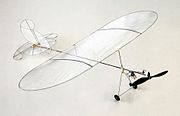The major distinction in aircraft types is between military aircraft, which includes not just combat types but many types of supporting aircraft, and civil aircraft, which include all non-military types.
Military aircraft

Combat aircraft divide broadly into fighters and bombers, with several in-between types such as fighter-bombers and ground-attack aircraft (including attack helicopters).
Other supporting roles are carried out by specialist patrol, search and rescue, reconnaissance, observation, transport, training and Tanker aircraft among others.
Many civil aircraft, both fixed-wing and rotary, have been produced in separate models for military use, such as the civil Douglas DC-3 airliner, which became the military C-47/C-53/R4D transport in the U.S. military and the "Dakota" in the UK and the Commonwealth. Even the small fabric-covered two-seater Piper J3 CubGlidersballoons have also been used as military aircraft; for example, balloons were used for observation during the American Civil War and World War I, and military gliders were used during World War II to land troops. had a military version, the L-4 liaison, observation and trainer aircraft. and
Civil aircraft

Civil aircraft divide into commercial and general types, however there are some overlaps.
Commercial aircraft
Commercial aircraft include types designed for scheduled and charter airlineairliners, the largest of which are wide-body aircraft. Some of the smaller types are also used in general aviation, and some of the larger types are used as VIP aircraft. flights, carrying both passengers and cargo. The larger passenger-carrying types are often referred to as
General aviation

General aviation is a catch-all covering other kinds of private and commercial use, and involving a wide range of aircraft types such as business jets (bizjets), trainers, homebuilt, aerobatic types, racers, gliders, warbirds, firefighters, medical transports, and cargo transports, to name a few. The vast majority of aircraft today are general aviation types.
Within general aviation, there is a further distinction between private aviation (where the pilot is not paid for time or expenses) and commercial aviation (where the pilot is paid by a client or employer). The aircraft used in private aviation are usually light passenger, business, or recreational types, and are usually owned or rented by the pilot. The same types may also be used for a wide range of commercial tasks, such as flight training, pipeline surveying, passenger and freight transport, policing, crop dusting, and medical evacuations. However the larger, more complex aircraft are more likely to be found in the commercial sector.
For example, piston-powered propeller aircraft (single-engine or twin-engine) are common for both private and commercial general aviation, but for aircraft such as turboprops like the Beechcraft King Air and helicopters like the Bell JetRanger, there are fewer private owners than commercial owners. Conventional business jets are most often flown by paid pilots, whereas the new generation of smaller jets are being produced for private pilots.
Experimental aircraft
Experimental aircraft are one-off specials, built to explore some aspect of aircraft design and with no other useful purpose. The Bell X-1 rocket plane, which first broke the sound barrier in level flight, is a famous example.
The formal designation of "experimental aircraft" also includes other types which are "not certified for commercial applications", including one-off modifications of existing aircraft such as the modified Boeing 747 which NASA uses to ferry the space shuttle from landing site to launch site, and aircraft homebuilt by amateurs for their own personal use.
Model aircraft

A model aircraft is a small unmanned type made to fly for fun, for static display, for aerodynamic research (cf Reynolds number) or for other purposes. A scale model is a replica of some larger design.

fanttastic and useful we blog thanks forload cell amplifier
ReplyDeleteAircraft weighing